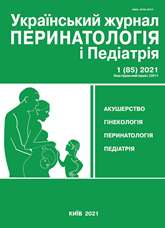A case of pregnancy complicated with Evance syndrome and heparin-induced thrombocytopenia
DOI:
https://doi.org/10.15574/PP.2021.85.91Keywords:
thrombocytopenia, hemolytic anemia, pregnancy, Evans syndrome, heparin-induced thrombocytopeniaAbstract
The simultaneous development of autoimmune hemolytic anemia and immune thrombocytopenia is known as Evans syndrome. This pathology is extremely rare during pregnancy, requires careful differential diagnosis and is associated with a high risk of hemorrhagic and thromboembolic complications. Treatment approaches for autoimmune hemolytic anemia and immune thrombocytopenia are similar, but in the case of autoimmune hemolytic anemia, thromboprophylaxis is mandatory. Heparin-induced thrombocytopenia is a serious adverse event of anticoagulation. One presents with a decrease in platelets but a paradoxical increase in thrombotic risk and mandates switching of the anticoagulant agent to a non-heparin one.
Clinical case. We describe the case of pregnancy complicated with Evans syndrome and development of heparin-induced thrombocytopenia at 28 weeks. Treatment of the underlying disease was effective on the use of first-line therapy. Fondaparinux and vitamin K antagonist (warfarin) have been used to treat heparin-induced thrombocytopenia. Monitoring of the fetal condition is carried out with careful control of Doppler ultrasound of the middle cerebral artery. Successful change of anticoagulant, close surveillance and carefully selected therapy allowed to achieve a successful termination of pregnancy. A healthy female newborn with body weight 2450 g, 8–8 Apgar scores was vaginally delivered uneventful at the 38th week. There were neither neonatal thrombocytopenia nor anemia. During the year after birth, the woman's condition is not worse, the child develops according to age.
An analysis of similar cases of pregnancy from the literature is described.
The research was carried out in accordance with the principles of the Helsinki Declaration. The informed consent of the patient was obtained for conducting the studies.
No conflict of interest was declared by the author.
References
Arepally GM. (2017). Heparin-induced thrombocytopenia. Blood. 129 (21): 2864-2872. https://doi.org/10.1182/blood-2016-11-709873; PMid:28416511 PMCid:PMC5445568
Chaudhary RK, Nepal C, Khanal N, Pathak R, Giri S, BhattVR. (2015). Management and Outcome of Heparin-Induced Thrombocytopenia in Pregnancy: A Systematic Review. Cardiovasc Hematol Agents Med Chem. 13 (2): 92-97. https://doi.org/10.2174/187152571302151217124957; PMid:26695420
Cuker A, Arepally GM, Chong BH, Cines DB, Greinacher A, Gruel Y, Linkins LA, Rodner SB, Selleng S, Warkentin TE, Wex A, Mustafa RA, Morgan RL, Santesso N. (2018). American Society of Hematology 2018 guidelines for management of venous thromboembolism: heparin-induced thrombocytopenia. Blood. 2 (22): 3360-3392. https://doi.org/10.1182/bloodadvances.2018024489; PMid:30482768 PMCid:PMC6258919
Fausett MB, Vogtlander M, Lee RM, Esplin MS, Branch DW, Rodgers GM, Silver RM. (2001). Heparin-induced thrombocytopenia is rare in pregnancy. Am J Obstet Gynecol. 185 (1): 148-152. https://doi.org/10.1067/mob.2001.114690; PMid:11483919
Felemban AA, Rashidi ZA, Almatrafi MH, Alsahabi JA. (2019). Autoimmune hemolytic anemia and ovarian dermoid cysts in pregnancy. Saudi Med J. 40 (4): 397-400. https://doi.org/10.15537/smj.2019.4.24l07; PMid:30957135 PMCid:PMC6506659
Greinacher A. (2021). 4Ts Score for Heparin-Induced Thrombocytopenia. Mdcalc. URL: https://www.mdcalc.com/4ts-score-heparin-induced-thrombocytopenia.
Hill QA, Stamps R, Massey E, Grainger JD, Provan D, Hill A. (2017). The diagnosis and management of primary autoimmune haemolytic anaemia. British Journal of Haematology. 176: 395-411. https://doi.org/10.1111/bjh.14478; PMid:28005293
Lauzikiene D, Ramasauskaite D, Luza T, Lenkutiene R. (2015). Pregnancy Induced Autoimmune Warm Antibodies Hemolytic Anemia: A Case Report. Geburtsh Frauenheilk. 75: 1167-1171. https://doi.org/10.1055/s-0035-1558131; PMid:26719601 PMCid:PMC4678053
Maroto A, Martinez Diago C, Tio G, Sagues M, Borrell A, Bonmati A, Teixidor M, Adrados C, Torrent S, Alvarez E. (2020). Autoimmune hemolytic anemia in pregnancy: a challenge for maternal and fetal follow-up. The Journal of Maternal-Fetal&Neonatal Medicine. 25: 1-3. https://doi.org/10.1080/14767058.2020.1732344; PMid:32098549
Mauermann E, Vokt C, Tsakiris DA, Tobler D, Girard T. (2016). Heparin-induced thrombocytopenia in pregnancy: an interdisciplinary challenge a case report and literature review. J Obstet Anesth. 26: 79-82. https://doi.org/10.1016/j.ijoa.2015.11.009; PMid:26775898
Pavord S, Hunt B. (2010). The Obstetric Hematology Manual. Cambridge University Press: 56-59. https://doi.org/10.1017/CBO9780511676451
Provan D, Arnold DM, Bussel JB et al. (2019). Updated international consensus report on the investigation and management of primary immune thrombocytopenia. Blood. 3 (22): 3780-3817. https://doi.org/10.1182/bloodadvances.2019000812; PMid:31770441 PMCid:PMC6880896
Rajasekhar A, Gernsheimer T, Stasi R, James AH. (2013). Clinical Practice Guidelines on Thrombocytopenia in Pregnancy. Thrombocytopenia-pocket-Guide. American Society of Hematology. https://doi.org/10.1182/blood-2012-08-448944; PMid:23149846
Ramadan MK, Hubeich M, Itani SE, Mogharbil A. (2016). Severe Gestational Thrombocytopenia: A Case Report and Brief Review of the Literature. Journal of Hematology. 5 (4): 142-150. https://doi.org/10.14740/jh308w
Rumyantsev AG, Maschan AA. (2014). Federalnyie klinicheskie rekomendatsii po diagnostike i lecheniyu sindroma Fishera Evansa. Rossiyskaya federatsiya.
Sacks DA, Platt LD, Johnson CS. (1981). Autoimmune hemolytic disease during pregnancy. Am J Obstet Gynecol. 140: 942-946. https://doi.org/10.1016/0002-9378(81)90089-2
Saha PK, Kaur J, Bagga R, Kalra JK, Jain A. (2017). A Rare Case of Successfully Treated Coombs Negative Immune Haemolytic Anaemia in Pregnancy. Journal of Clinical and Diagnostic Research. 11 (2): 6-7. https://doi.org/10.7860/JCDR/2017/22274.9409; PMid:28384940 PMCid:PMC5376850
Suzuki H, Yamanoi K, Ogura J, Hirayama T, Yasumoto K, Shitanaka S, Inayama Y, Sakai M, Ohara T, Suginami K. (2019). A Case of Pregnancy Complicated with Evans Syndrome with Sequential Development of Autoimmune Warm Antibody Hemolytic Anemia and Idiopathic Thrombocytopenic Purpura. Case Reports in Obstetrics and Gynecology: 1-5. https://doi.org/10.1155/2019/2093612; PMid:30733882 PMCid:PMC6348819
Zanella A, Barcellini W. (2014). Treatment of autoimmune hemolytic anemias. Haematol. 99 (10): 1547-1554. https://doi.org/10.3324/haematol.2014.114561; PMid:25271314 PMCid:PMC4181250
Downloads
Published
Issue
Section
License
The policy of the Journal “Ukrainian Journal of Perinatology and Pediatrics” is compatible with the vast majority of funders' of open access and self-archiving policies. The journal provides immediate open access route being convinced that everyone – not only scientists - can benefit from research results, and publishes articles exclusively under open access distribution, with a Creative Commons Attribution-Noncommercial 4.0 international license(СС BY-NC).
Authors transfer the copyright to the Journal “MODERN PEDIATRICS. UKRAINE” when the manuscript is accepted for publication. Authors declare that this manuscript has not been published nor is under simultaneous consideration for publication elsewhere. After publication, the articles become freely available on-line to the public.
Readers have the right to use, distribute, and reproduce articles in any medium, provided the articles and the journal are properly cited.
The use of published materials for commercial purposes is strongly prohibited.

